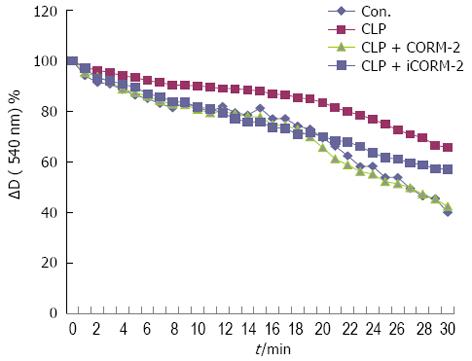Copyright
©2014 Baishideng Publishing Group Co.
World J Gastroenterol. Mar 28, 2014; 20(12): 3301-3311
Published online Mar 28, 2014. doi: 10.3748/wjg.v20.i12.3301
Published online Mar 28, 2014. doi: 10.3748/wjg.v20.i12.3301
Figure 6 Effect of carbon monoxide-releasing molecule II on hepatic mitochondrial function in septic mice.
Mice were challenged with cecal ligation and puncture (CLP) and treated with tricarbonyldichlororuthenium (II) dimer (CORM-2) or iCORM-2 as described in the Methods section. Isolated mitochondria were resuspended in the assay buffer. Ca2+-induced mitochondrial swelling was assayed by the decrease in absorbance at 540 nm. The CLP group of mice had significant hepatic mitochondrial swelling with severely damaged mitochondrial function. Following CORM-2 intervention, the extent of hepatic mitochondrial swelling was reduced and mitochondrial function was clearly protected (P < 0.05 vs CLP mice). The curves represent typical recordings from experiments of at least three different mitochondrial preparations.
- Citation: Liang F, Cao J, Qin WT, Wang X, Qiu XF, Sun BW. Regulatory effect and mechanisms of carbon monoxide-releasing molecule II on hepatic energy metabolism in septic mice. World J Gastroenterol 2014; 20(12): 3301-3311
- URL: https://www.wjgnet.com/1007-9327/full/v20/i12/3301.htm
- DOI: https://dx.doi.org/10.3748/wjg.v20.i12.3301









